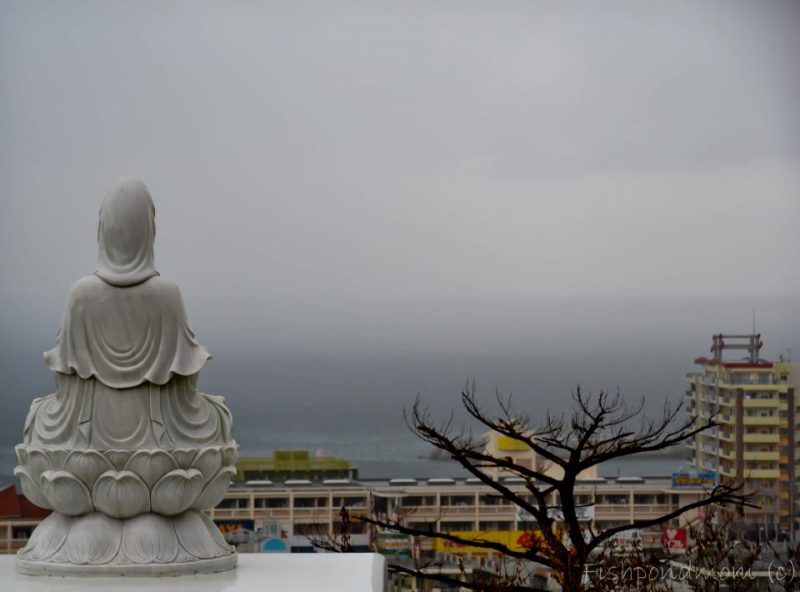

Looking west on the day of an equinox – September 22, 2012 – in Nago, Okinawa, Japan via Beverly Fish. Thank you, Beverly.
In Chinese tradition, the autumn season is associated with the color white, the sound of weeping, the emotions of both courage and sadness, the lung organ, the metal element, and a white tiger. Autumn is also connected in Chinese thought with the direction west, considered to be the direction of dreams and visions.
What does all this mean? It’s a system – a cosmology if you will – that describes how nature works.

Image via Vincent Wong/Flickr
To the Chinese, nature means more than just the cycling of the seasons. Nature is within and around us, in all things. The basic cycles of nature, as understood by the early Chinese philosophers, are easily comprehensible by Western students of nature. They ring true. After all, Chinese civilization flourished for 15 centuries before the Roman Empire came to be. Today we know it’s part of Chinese culture to maintain and add to ancient wisdom. In contrast, we in the Western world tend to replace old ideas with new ideas. So – although our Western way of thinking encourages advances in things like technology and economics – the Chinese understanding of natural cycles remains far deeper than ours.
Here’s a quick and easy lesson on one Chinese way of thinking about nature and its cycles. We all experience the fact that things sprout and begin to grow (spring). They fire up or ignite or bloom (summer) and reach completeness (late summer). They begin to dry and wither (autumn). They rest (winter). In Chinese way of thinking about the world known as Wuxing – which traslates to the Five Elements or Five Phases – these five seasons represent not only an Earth cycle, but also cycles within the cosmos, within our human relationships and endeavors, and within our own bodies. It’s easy to see these cycles continuing endlessly, with each period of blossoming and completeness (summer) followed by a drying and a withering (autumn) and then rest (winter) before spring comes again.
Each of the five phases or seasons of ancient Chinese philosophy carries associations with specific things – not only spring, summer, fall and winter – but also colors, sounds, organs in the body, the cardinal directions, fundamental elements such as wood, fire, earth, metal, and wood, and real or mythological beasts.
Here’s a simple example. While summer is associated with the the emotion of joy, autumn is associated with both courage and sadness. You can probably feel the truth of that association for yourself, because, in autumn, things are dying. The light is dying, for one thing, as Earth’s orbit around the sun and tilt on its axis combine to carry us in this hemisphere further away from receiving the sun’s rays most directly. The days are getting shorter. Plants and trees are winding down their cycle of growth. Sadness – and courage – are natural emotions as these changes are taking place.
That’s part of what the Chinese philosophy of the five phases or five elements is trying to convey: for example, sadness is part of the autumn season. It’s just part of nature.
So to celebrate the autumn equinox as the Chinese philosophers did, you might …
Stand facing west, considered the direction of autumn in ancient Chinese philosophy. Just stand for a few moments and honor the “westness” of autumn. Consider your dreams and visions, and the path on which you’re moving forward through your life.
Light white candles against the growing darkness of the season. Or place white flowers on your table. White is the color of autumn in the Chinese tradition.
Allow yourself to weep for things you have lost. Weeping is the sound of this season, according to Chinese philosophy.
Find the courage to face what’s ahead.

Autumn in Tachuan, China. Image via Xianyi Shen/Flickr
Bottom line: A quick and easy lesson on one Chinese way of thinking about nature and its cycles – called Wuxing, the Five Elements or Five Phases – as it relates to the autumn equinox.
A Chinese perspective on the spring equinox
A Chinese perspective on summer
from EarthSky https://ift.tt/2FT0h6x


Looking west on the day of an equinox – September 22, 2012 – in Nago, Okinawa, Japan via Beverly Fish. Thank you, Beverly.
In Chinese tradition, the autumn season is associated with the color white, the sound of weeping, the emotions of both courage and sadness, the lung organ, the metal element, and a white tiger. Autumn is also connected in Chinese thought with the direction west, considered to be the direction of dreams and visions.
What does all this mean? It’s a system – a cosmology if you will – that describes how nature works.

Image via Vincent Wong/Flickr
To the Chinese, nature means more than just the cycling of the seasons. Nature is within and around us, in all things. The basic cycles of nature, as understood by the early Chinese philosophers, are easily comprehensible by Western students of nature. They ring true. After all, Chinese civilization flourished for 15 centuries before the Roman Empire came to be. Today we know it’s part of Chinese culture to maintain and add to ancient wisdom. In contrast, we in the Western world tend to replace old ideas with new ideas. So – although our Western way of thinking encourages advances in things like technology and economics – the Chinese understanding of natural cycles remains far deeper than ours.
Here’s a quick and easy lesson on one Chinese way of thinking about nature and its cycles. We all experience the fact that things sprout and begin to grow (spring). They fire up or ignite or bloom (summer) and reach completeness (late summer). They begin to dry and wither (autumn). They rest (winter). In Chinese way of thinking about the world known as Wuxing – which traslates to the Five Elements or Five Phases – these five seasons represent not only an Earth cycle, but also cycles within the cosmos, within our human relationships and endeavors, and within our own bodies. It’s easy to see these cycles continuing endlessly, with each period of blossoming and completeness (summer) followed by a drying and a withering (autumn) and then rest (winter) before spring comes again.
Each of the five phases or seasons of ancient Chinese philosophy carries associations with specific things – not only spring, summer, fall and winter – but also colors, sounds, organs in the body, the cardinal directions, fundamental elements such as wood, fire, earth, metal, and wood, and real or mythological beasts.
Here’s a simple example. While summer is associated with the the emotion of joy, autumn is associated with both courage and sadness. You can probably feel the truth of that association for yourself, because, in autumn, things are dying. The light is dying, for one thing, as Earth’s orbit around the sun and tilt on its axis combine to carry us in this hemisphere further away from receiving the sun’s rays most directly. The days are getting shorter. Plants and trees are winding down their cycle of growth. Sadness – and courage – are natural emotions as these changes are taking place.
That’s part of what the Chinese philosophy of the five phases or five elements is trying to convey: for example, sadness is part of the autumn season. It’s just part of nature.
So to celebrate the autumn equinox as the Chinese philosophers did, you might …
Stand facing west, considered the direction of autumn in ancient Chinese philosophy. Just stand for a few moments and honor the “westness” of autumn. Consider your dreams and visions, and the path on which you’re moving forward through your life.
Light white candles against the growing darkness of the season. Or place white flowers on your table. White is the color of autumn in the Chinese tradition.
Allow yourself to weep for things you have lost. Weeping is the sound of this season, according to Chinese philosophy.
Find the courage to face what’s ahead.

Autumn in Tachuan, China. Image via Xianyi Shen/Flickr
Bottom line: A quick and easy lesson on one Chinese way of thinking about nature and its cycles – called Wuxing, the Five Elements or Five Phases – as it relates to the autumn equinox.
A Chinese perspective on the spring equinox
A Chinese perspective on summer
from EarthSky https://ift.tt/2FT0h6x


Aucun commentaire:
Enregistrer un commentaire